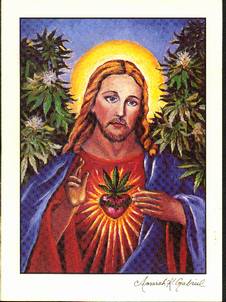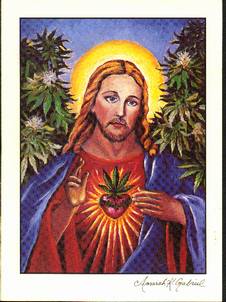
A young millennial I know posted the following on Facebook:
I get tired of people who lift up weed to the point that they say its a cure for all or everyone needs it. Just like any drug it can work for some people and others it may not effect them the same way. You should accept people regardless of how it effects them and help them by being a friend if it seems to be negative towards them. Everyone’s bodies and minds are not equally affected on certain drugs. So remember that next time you try and talk someone into smoking after they have already declined…
As soon as I read this I realized it was time to write about a subject I’ve spoken about often but never committed to print.
People not affiliated with any religion often unconsciously create religions out of various things. Multi-level marketing schemes, nationalism, guns, drugs, a sexual orientation, pseudo-skepticism and atheism, an extreme dietary practice, bodybuilding, activism, etc. can all be turned into religions complete with images of salvation and damnation, sin, virtue and dogmatic absolutisms.
Each of these new religions will have something that is inflated and deified and contrasted with something else that is demonized. And, of course, true believers factionalize, they socially polarize, you are either born again or you are going to hell, you are either a righteous celebrator of cannabis as a cure for everything or you are demonizer spreading reefer madness propaganda.
People are most likely to create an idealizing religion out of something which has been repressed for a long time. In the West we’ve repressed sex and plant medicines for millennia. Repression is on one side of the polarization coin and idealization is on the other. The oscillation of our attitudes toward sex closely parallels the oscillation of our attitudes toward plant medicines so I’m going to have a lot to say about the sexual dynamic before circling back to cannabis.
A polarized coin tends to flip to its opposite side. It is not surprising that we would replace the harsh repression of sex and plant medicines with the highly conventionalized polar opposite—the sex, drugs and rock n’ roll lifestyle where a chaotic hedonism of promiscuity and intoxication is thought to be revolutionary and avant-garde.
You can always tell which people live on a polarized coin because whichever side of it they inhabit they share a bond of absolutism. Cannabis is either the “devil’s weed” of a divine plant goddess that is a cure for everything.
The flipping back and forth of the polarized coin is what Hereclitus called “enantiadromia.” I wrote about this principle in the philosophy I developed called Dynamic Paradoxicalism:
One reason why people and groups tend toward absolutisms is the principle known as enantiadromia (en-ANT-ee-a-DROH-mee-a). Jung used the term frequently, but it originates with Heracleitus (b. 540 BC) (also spelled “Heraclitus’) who seems to be one of the earliest dynamic paradoxicalists. According to Encyclopaedia Britannica,
A significant manifestation of the logos, Heraclitus claimed, is the underlying connection between opposites. For example, health and disease define each other. Good and evil, hot and cold, and other opposites are similarly related. In addition, he noted that a single substance may be perceived in varied ways—seawater is both harmful (for men) and beneficial (for fishes). His understanding of the relation of opposites to each other enabled him to overcome the chaotic and divergent nature of the world, and he asserted that the world exists as a coherent system in which a change in one direction is ultimately balanced by a corresponding change in another. Between all things there is a hidden connection, so that those that are apparently “tending apart” are actually “being brought together.”
“Heraclitus” from Encyclopædia Britannica 2007 Deluxe Edition.
The physical science of the ancients was preoccupied with earth, air, wind, and fire as the fundamental constituents of reality. Heracleitus was part of that point of view, and he fell for a rather one-sided absolutism that fire was the ultimate constituent and water, earth, and everything else, derived from it.
A savagely cruel and ironic sort of enantiadromia played out in Heracleitus’s own fate:
The death of Heracleitus is perhaps philosophy’s saddest case of the failure of theory to work in practice. Heracleitus identified fire as the principle element of nature and creation. The human soul, as part of the world soul Logos, was man’s fiery part and had to be protected from its opposite, moisture, which dampened the fires while asleep and in excess caused madness. It can only be regarded as tragic irony that he should suffer from dropsy, a condition in which water accumulates in the body. He died in his desperate attempts to draw the moisture out through heat by plastering himself with dung.
from: http://www.creatorix.com.au/philosophy/02/02f07.html
Enantiadromia is the tendency of living systems to oscillate between extremes. Heraclietus coined the term and ultimately personified it—a fire absolutist who died of excess water.
Here’s a more familiar example: someone begins a romantic relationship absurdly idealizing someone, an infatuation, a type of enchantment which leads to the equal and opposite disenchantment. The disenchantment, the inversion of the idealization, is an equally polarized view of the former beloved as the worst jerk to have ever lived. Another example: Someone puts himself on an overly restrictive diet and this leads to the equal and opposite binge.
Collectively, many religious systems set up harsh taboos around sexuality, and this leads to the modern tendency to rebel toward promiscuity. Catholic priests have been known to personify enantiadromia in unfortunate ways. The pendulum of enantiadromia can often be an unconscious way of relating to paradox, where an individual or collective fluctuates between the extreme poles of the paradox—like celibacy/promiscuity. Someone rebels from feeling like a victim into believing absolutely in the you-create-your-own-reality principle, where the universe revolves around the individual.
Some versions of a key Ken Wilber insight, the “pre/trans fallacy,” seem to relate to enantiadromia. Essentially, the pre/trans fallacy notices a common tendency to confuse pre-rational states with trans-rational states, since both are non-rational. The “reductivist” version of this is the tendency of “scientism,” which reduces all transrational mystical states to prerational infantilism, and dismisses authentic spiritual experience as “superstitious nonsense.” Freud clearly fell for this half of the fallacy, especially in The Future of an Illusion.
The “elevationist” version of the fallacy, ubiquitous in the New Age, is to elevate prerational states to the transcendent and to demonize rationality. From this side of the fallacy, babies are thought to be Buddhas, and anything tribal or aboriginal is romanticized and inflated as infinitely superior to anything modern. Promiscuity is seen as a daring rebellion from antiquated taboos, even though it is usually in high conformity to what peers are doing. An elevationist may recognize the sexual mores of the past as conventional, but fail to recognize that their “rebellion” into promiscuity is part of a vast conventionalism of the present, and that this new conventionalism is actually based on a still more primitive level of development than the old conventionalism. Regressing to pre-rational hedonism, indulging every impulse and irrational notion is seen as enlightened, post-conventional and transcendent. This is the state of the typically goofy New Age person who never heard an urban legend or bit of mystical-sounding nonsense without adopting it wholesale. This type of person is fiercely anti-intellectual and anti-rational, so it is impossible to talk them down from their absurdities, even the attempt to do so casts you, in their minds, as this clueless rationalist stuck in their ego. They believe they have transcended rationality, while forgetting that to transcend something you first have to achieve it!
Falling for the pre/trans fallacy usually means that someone is caught on the pendulum of enantiadromia and has fallen for absolutisms. Achieving rationality, analytic ability, and discernment seems too dry and difficult so one swings back to infantile magical thinking and pretends that it is transcendent. Building a strong, conscious ego able to withstand the outrageous slings and arrows of fortune seems too difficult, and so the pendulum swings back to infantile omnipotence, and a confused person believes in you-create-your-own-reality as an absolutism.
One collective aspect where the polarized coin of enantiadromia has played out is sexuality. In Born Under a Blood Red Moon—Metamorphosis of the Feminine in the Dreams of Young Women, I discuss the enantiadromia of the archetypes of the White Madonna and the Black Madonna:
Not all that long ago, peaking during the Victorian era and continuing into the Edwardian—and in some places still continuing—was the patriarchal model for femininity called “the White Madonna.” Young women were expected to be virgins before marriage, to be without impure thoughts, and to be prim, proper, passive, and on a pedestal. In our time, the pendulum of enantiodromia has swung, and now in popular culture young women are expected to be the other side of the patriarchal coin, the “Black Madonna,” which is something like a professionally trained young harlot.
In Britain, where not too long ago they were putting pantaloons on piano legs so as not to give young people lascivious notions, magazines for adolescent girls —conditioning manuals— are now incredibly raunchy and advertise how to improve your oral sex techniques, how to cheat on your boyfriend without him knowing, and, of course, how to lose weight.
A couple of years ago I was in a mall here in Colorado, just outside of Boulder, and walked past a shop that sold clothes, accessories, and cosmetics targeted for adolescent girls. I saw a couple of mothers in this shop with their adolescent daughters. The shop had one and only one huge poster that was obviously meant to suggest the theme of the whole establishment. Depicted on the poster was a barely pubescent girl in a black, seductive Victoria’s Secret type negligee, sitting on a bed with her legs spread apart. She wore a desolate and licentious look on her face reminiscent of the character Brook Shields played in the 1978 film, Pretty Baby, where she is the youngest harlot in a New Orleans whorehouse, circa 1917. The caption of the poster reads “Femme Fatale.” In other words, here is the place to purchase all the accoutrements you need to suit up as a pubescent Black Madonna.
Sexuality, and eros in general, has undergone a patriarchal enantiodromia or pendulum swing. Not too long ago in Western culture, and continuing to this day in many subcultures, sexuality was highly repressed and was supposed to occur only in marriage and for the purpose of reproduction. This form of patriarchal sexuality flipped, especially in the 1960s, and the new norm became promiscuity. As the lyrics of the classic 1970 song by Crosby, Stills, Nash and Young put it: “If you can’t be with the one you love, love the one you with.”
What both sides of this extreme oscillation have in common is the patriarchal destruction of eros. “Eros” is being used here to refer to a person’s capacity for deep communion or even oceanic merger with another. Eros does not necessarily have to involve physical intimacy and it is quite common for sexual transactions to involve no eros at all. Pornographic sex on the level of the genitalia, sex as a metaphor for power, and many other popular versions of sex may be entirely unerotic.
The more recent patriarchal norm for sexuality, the anything goes approach, is in some ways even more male-dominated than the older version that emphasized repression. Male sexuality has biological underpinnings predisposing it toward promiscuity. The reproductive advantage for males is to deposit their sperm in as many places as possible, but for females it is to have a single stable partnership that will help during pregnancy, nursing and bringing up a child (though some feminist writers dispute that). Before AIDS, certain sectors of the male gay community, witnessed some of the more extreme forms of impersonal promiscuity in gay bathhouses, etc. With no females around to moderate sexual behavior, they defaulted to the male biological tendency toward promiscuity.
Very much like the enantiodromia of menstruation (once seen as dark and dangerous, but now diminished into hygienic inconvenience), sexuality was once seen as powerful, dark, dangerous, and in need of taboo and intense restriction. In the degraded patriarchal/materialist counter view, it is no more significant than a mutual back rub. An absurd by-product of this counter view was one of the most oxymoronic phrases invented, “casual sex.” But sex isn’t casual on the microbiological plane—it could start a life or end a life. As above, so below. It isn’t casual on higher planes either. When you have sex with someone you are merging your essence with them, energetic fields are colliding, and neither person will ever be quite the same again. But to the modern patriarchal materialist, sex was described —especially pre-AIDS— as no different than any other form of cardio exercise like running or bouncing on a trampoline. (See George Leonard’s excellent book The End of Sex: Erotic Love after the Sexual Revolution). The publication of Alex Grey’s book Sacred Mirrors, was a huge cultural milestone, because a vision was revealed of sex and eros as a profoundly transformative experience of energetic merger, as well as of anatomical penetration.
See my multi-part Alex Grey series, A Spiraling Eye Encrusted Overview of the Art of Alex Grey for more on this. Oh, and Alex just read this article, minutes after it went online, and made this comment in an email:
People who deify plant medicines often idealize festival culture without seeing its highly conventionalized shadow, the same-old, same-old golden oldie of sex, drugs and rock n’ roll (or techno) lifestyle. In my essay on Burning Man, Incendiary Person in the High Desert Carnival, I wrote about the tendency in festival culture to glamorize promiscuity as something revolutionary and avant garde:
Wilber, and others who are influenced by the “Spiral Dynamics” model of human evolution, talk about the “pre/trans” fallacy. People seek to rebel from the conventional by regressing to the preconventional, while falsely believing that they have transcended the conventional. People rebel from the earlier form of conventional sexuality (uptight, fundamentalist repression) by embracing the new norm (promiscuity), and yet they convince themselves they are being daring and avant-garde and so forth, when they are actually just conforming to an enantiodromia that is reverting to the preconventional—a primitive and unerotic form of sexuality.
The new patriarchal norm for sexuality, exploitive promiscuity, is particularly toxic for women, as it is, like the body type they are expected to emulate, based on adolescent masculinity. Romantic relationships are generally expected to involve sexual exchange very early in their development, and this, I believe, is a major reason why they tend to fail so quickly. However compatible two people might be, by engaging such an ultimate state of intimacy, when there is no foundation of emotional intimacy nor recognition of the complexity of the other person, when one is still dealing mostly with projections and counter-projections, the result is mostly a short-circuiting of the gradual development of an intimate relationship. Beginning a relationship with ultimate intimacy can often create an inherently unstable structure, bound to topple, especially as idealizing projections revert to disillusionments. However, I don’t want to fall into the patriarchal tendency of one-size-fits-all pronouncements on sexuality, because if there is anything that should be obvious about sexuality and eros it is the fantastic individual variability of every part of it, so there should never be a standardized template set out for everyone to follow in every circumstance.
What I also find absurd are people who justify promiscuity as virtuous with the claim that they are helping to “overcome inhibitions.” Typically they speak as if they were rebelling from Victorian England rather than the present sex-saturated era. Worse, they conflate inhibition with repression and foolishly presume that it is necessarily negative. But many neurological functions are inhibitory; inhibition is essential to survival and efficient functioning. Ask someone with Tourette’s Syndrome what it’s like to have a deficit of inhibitory function. Losing inhibitions is usually disempowering, a loss of free will. Most of us could benefit from greater powers of inhibition in a number of areas in our lives. As Goethe says, “A master first reveals himself by his ability to hold back.”
The repression of sexuality turning into the glamorizing of promiscuity and the demonization of plant medicines turning into the deification of plant medicines is a parallelism within the same collective enantiadromia. The demonizers and the deifiers share a common bond of absolutism, a common inability to recognize the dynamic paradox of opposites within everything (see Dynamic Paradoxicalism).
The divine and demonic aspects of sex are playing out every moment and so are the divine and demonic aspects of drugs. If you want to identify with one side of the paradox, of course you can find ample evidence to support that just as the other side can.
An alternative to the absolutism approach to plant medicines is the aware, individualized, dynamic approach. Everyone needs to be their own alchemist and to make their own choices without regard to the absolutist dogmas of either side.
I live in Boulder, Colorado the country’s capital of cannabis capitalism and culture. Since legalization, Boulder continues to be the healthiest and best educated city in the country. Despite the munchies, cannabis demonizers tend to live in the south, the most obese region of the country while Colorado remains the leanest of the fifty states. I have always supported legalization and ultimately I think legalization will help people to like move past the silly twins of demonization and deification.
Most of my closest friends in Boulder work in the cannabis industry. Most of them are highly health conscious and the easy availability has led them toward a more conscious relationship to the plant.
On the other hand, I also know people who over indulge and for whom cannabis is an overall detriment in their lives. As soon as I hear someone say, “I just want to smoke a bowl and go to sleep” I know I am in the presence of the shadow side of this medicine. Such a person has made a soporific out of an hallucinogen and it’s lost the value it could have had. For chronic stoners cannabis is no more divine than another can of beer is for Joe Six Pack. Another classic sign of a degraded relationship to cannabis is when people imbibe it socially and then default into talking about cannabis. In other words, they’ve taken a potentially deconditioning substance but they are having an experience with no content except the substance itself. In such circles, weed is merely a catalyst for small talk characterized by a high degree of conformity to stoner subculture. A potential deconditioning hallucinogen has been reduced to a conditioning agent of depotentiation and a slacker group mind. They might as well be eating cheesecake and having coffee talk in the church basement before an evening of bingo.
To ground this, I’ll close with an example of how I use cannabis. I happen to love cannabis (as a medicine, not a deity) and have found it to be a great ally for my creative process. But let me be clear, this is an example, not a guiding formula for others to follow. With sexuality, with drugs, with anything, I am a dynamic paradoxicalist and not a one-size-fits-all formula prescriber. I favor a dynamic and individualized approach.
For me, I have found that cannabis works best when I partake of it sparingly so that it continues to be a mild hallucinogen. Here’s how I typically use it:. I go several days without it and during those several days I am eating well, exercising, sleeping well, etc. Then, at about 4AM on say the sixth day of that (predawn is my magical writing zone see Predawn Window Zone) I will take, on an empty stomach, one edible, a piece of candy, precisely infused with 10mg of THC. This small dose, which a chronic stoner might barely notice, will be enough for me to be lifted off the baseline of my usual consciousness and into a state of heightened intuition for a few hours. That can be quite magical, but to put it in perspective arising from the dreamtime predawn and drinking some mate is also enough for me to have a few hours of heightened intuition and creative magic most days. THC can further enhance that and it can also enhance my experience of a visionary film or an intense one-on-one dialogue with an interesting person.
I try to be a wise alchemist to get the maximum value and the minimum cost from substances. My experience of cannabis is that it can have a very yin effect. Too much of it can diminish the yang fire element and leave you depleted, “burned out” in a slowed down slacker mode with no fire in the belly. Since I am a very fiery person, cannabis is often an amazing counterbalance opening a more feminine experience of things.
I also find that the yin and yang alchemy needs to be seasonally adjusted. In the summer, the yang energy is strong and I can use cannabis more frequently without feeling my fire depleted. The winter is very yin so I use it more infrequently. Similarly, Chinese alchemists say that men can ejaculate more frequently in the summer but would be depleted by such a frequency in the winter. Similarly, although I am a very fiery person, I am getting older and aging is yin, so season of lifecycle as well as season of the year is relevant. Right now it is winter, but I have also intensified my cardio workouts recently and that has built a lot of inner fire, etc. and if I feel depleted by THC an intense cardio workout will bring me back up. This is just an example of how I think about cannabis and attempt to use it thoughtfully so I can maximize its divine potential and minimize the downsides.
Again, I’m not saying my view of the yin-yang alchemy of cannabis is the right one for everyone, I’m just using my relationship to cannabis as illustrative example.
What I am recommending is a thoughtful, dynamic, individualized relationship to a substance while just saying know to the absolutisms of demonization and deification.
 ZapOracle.com home to the free 720-card Zap Oracle
ZapOracle.com home to the free 720-card Zap Oracle








